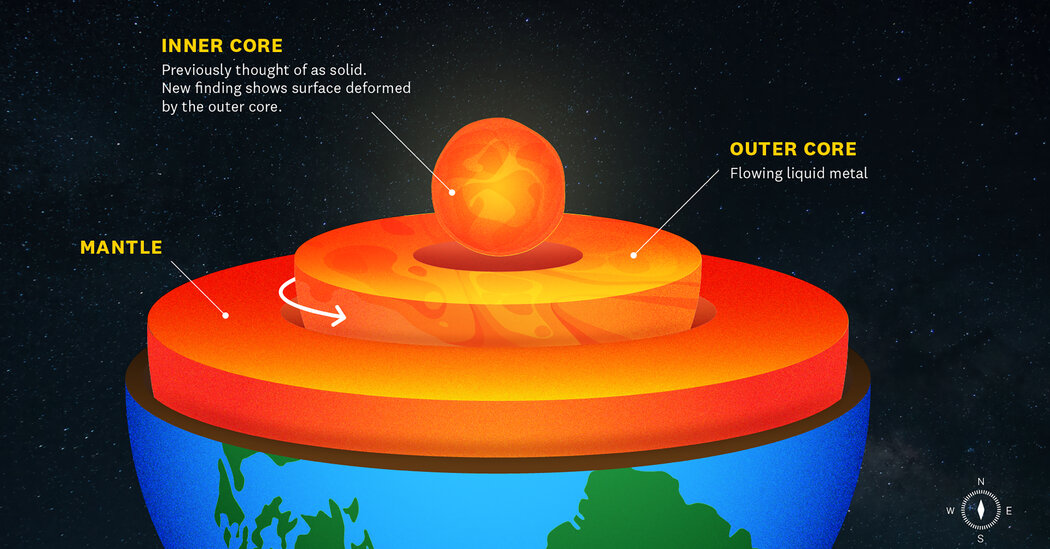
Scientists Detect Shape-Shifting Along Earth’s Solid Inner Core
- Science
- February 10, 2025
- No Comment
- 2
The inner core at the center of the Earth, a ball of iron and nickel about 1,500 miles wide, may not be perfectly solid.
A new study finds evidence that the inner core’s outer boundary has noticeably changed shape over the past few decades.
“The most likely thing is the outer core is kind of tugging on the inner core and making it move a little bit,” said John Vidale, a professor of earth sciences at the University of Southern California.
Dr. Vidale and his colleagues reported their findings on Monday in the journal Nature Geoscience.
That adds to the mysteries about the planet’s center. Geophysicists have previously reported that the inner core does not spin at exactly the same rate as the rest of Earth. They also showed that the pace of rotation changes — the inner core appeared to be spinning slightly faster than the outer layers a couple of decades ago, and now it is spinning slightly slower.
The inner core is the deepest of Earth’s geological layers. The crust — the layer that we live on — is just a few miles thick. Below that, filling up 84 percent of the planet, is the 1,800-mile-thick mantle, which is soft enough in places to flow up and down and generate the forces that push the continents around. Between the mantle and the inner core is the liquid outer core.
Scientists of course cannot cut into Earth and directly observe its insides. Instead, their knowledge is inferred from the vibrations generated by earthquakes that pass through the planet. The speed and the direction of the seismic vibrations change depending on the density and the elasticity of the rocks.
For this study, Dr. Vidale and his colleagues looked at earthquakes in the South Sandwich Islands, a volcanic chain in the South Atlantic Ocean.
So many earthquakes happen there that sometimes a new event is almost identical in magnitude and location to one that occurred years earlier.
The scientists identified more than 100 such “earthquake pairs,” analyzing readings from 1991 to 2004 at two arrays of seismometers more than 8,000 miles away from the islands, one near Fairbanks, Alaska, the other in Yellowknife, Canada.
The analysis originally aimed to improve on earlier work that suggested a slowing of the inner core’s spin. But the scientists did not understand aspects of the signals at the Yellowknife array.
“Basically, the wiggles are different,” Dr. Vidale said.
By coincidence, for some of the pairs, the inner core was in the same orientation during both quakes.
Identical earthquake vibrations passing through the identical part of the Earth should have produced identical seismic signals at Fairbanks and Yellowknife. At Fairbanks, that was true, but at Yellowknife the signals were different.
Because Yellowknife is somewhat closer to the South Sandwich Islands than Fairbanks is, the seismic waves from the islands’ earthquakes did not travel as deeply into the inner core as those reaching Fairbanks. That suggested something had changed near the outer boundary of the inner core.
Turbulent flow in the outer core or gravitational pull from denser parts of the mantle could have deformed the inner core boundary, which might account for the change in the seismic signals, Dr. Vidale said.
“We expect it’s soft because it’s near melting point,” he said. “So it’s no surprise if it deforms.”
The new findings will not be the last on the subject. “The offered interpretation is sound,” said Hrvoje Tkalcic, a professor of geophysics at the Australian National University who was not involved with the research, “although it is not the only possible explanation, as the authors acknowledge.”
In recent years, geophysicists have argued over whether differences in the seismic signals are caused by a change in the rotation rate or by a change in the shape of the inner core. “This study thus reconciles the last debate by proposing a combination of both causes,” Dr. Tkalcic said.
Lianxing Wen, a professor of geosciences at Stony Brook University in New York who in 2006 reported possible changes of shape at the inner-core boundary, remains unconvinced that the inner core spins at a rate different from that of the rest of Earth.
Dr. Wen said the Yellowknife data was inconsistent with that hypothesis. “Ordinarily, such inconsistencies should lead to an abandonment of the original inconsistent interpretation,” he said.
A change in shape, without any change in the rotation rate, was enough to explain the seismic data, Dr. Wen said.
Even Dr. Vidale is not completely convinced he is correct. “We’re pretty sure we were right, but this isn’t a bulletproof paper,” he said. “How sure? I sort of put it at 90 percent.”
Dr. Tkalcic said more data was needed to resolve the question, which “can be achieved by building seismological infrastructure in remote areas of the planet, including the ocean floor.”
Xiaodong Song, a professor at Peking University in China who in the mid-1990s was one of the first to propose that the inner core was spinning at a different speed from that of the Earth’s surface, agreed.
“This new study,” Dr. Song said, “should motivate a new round of exploration into strange behaviors at the heart of the planet.”
#Scientists #Detect #ShapeShifting #Earths #Solid #Core









